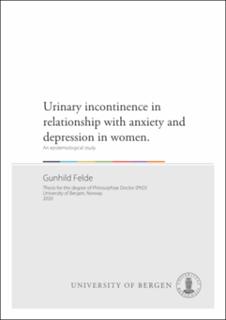| dc.description.abstract | Summary:
Urinary incontinence (UI) affects a large proportion of women during their lives. Pregnancy and parity, obesity and increasing age are regarded as the most important and best documented risk factors for UI in women. Many co-morbid conditions are associated with increased prevalence of UI, such as diabetes, coronary heart disease, cerebral stroke, asthma/COPD, rheumatoid arthritis and chronic musculoskeletal pain. Studies have also shown an association between symptoms of anxiety and depression and UI. Especially urgency UI and overactive bladder have been investigated in relationship with anxiety and depression. The serotonergic and noradrenergic system has a place in the pathophysiology in both UI, anxiety, and depression, which supports the epidemiological substrate.
The documented effect of treatment with the serotonin- and noradrenaline reuptake inhibitor duloxetine on stress UI, also strengthens the hypothesis of a common underlying biological association between the conditions.
This thesis is an epidemiological study of the associations between anxiety and UI and depression and UI in women. The aims of the thesis were:
- To determine if anxiety and depression is associated with UI in middle-aged women, and to investigate a possible association with type and severity of UI.
- To investigate the association between anxiety/depression and UI in a 10-year follow-up study.
- To determine the association between anxiety/depression and UI in a population with women 20 years+, and to investigate if the associations are influenced by using psychotropic drugs.
Our studies are based on data from The Hordaland Health Study (HUSK) (Paper I), the Nord-Trøndelag Health Study (HUNT) (Paper II and Paper III) and the Norwegian Prescription Database (NorPD) (Paper III). The questions about UI were identical in these surveys and consisted of an opening question if the women had experienced leakage of urine and further questions about type, frequency and amount of leakage. The Norwegian version of the questionnaire Hospital Anxiety and Depression Scale (HADS) was used in both surveys to measure the level of anxiety and depression.
Paper I:
Paper I is based on data from HUSK. The study population consisted of 5321 women 40-44 years of age who answered the questionnaire, which contained both the HADS- and UI-questions. The prevalence of UI was 26%. Of these, 53% had stress UI, 9% urgency UI and 30% mixed UI. We found an association both between anxiety and UI, and between depression and UI, strongest for mixed UI, urgency UI and severe UI. Of the whole study-population 20% had anxiety and 8% depression, among women with mixed UI, 32% had anxiety and 17% depression, and in the group with severe UI, 34% had anxiety and 16% depression.
Paper II:
Paper II was based on data from both HUNT2 and HUNT3. The study population consisted of 16.263 women who had answered the questionnaires about UI, anxiety and depression in HUNT2 and HUNT3. We wanted to compare the development of anxiety and depression over the 10-year follow-up among those who had UI in HUNT2 compared with those who were continent in HUNT2. We also wanted to compare development of UI among those with anxiety and among those with depression in HUNT2, compared with development of UI among those without anxiety and depression in HUNT2. We found that anxiety and depression in HUNT2 was associated with increased risk of development of UI, strongest for the urgency component of UI. This association was strongest in the groups with the highest HADS-scores. UI in HUNT2 was also associated with increased risk of development of anxiety and depression, strongest for mild anxiety/depression.
Paper III:
Paper III was based on data from the HUNT3 and the NorPD. 21803 women who had answered the UI-questions in HUNT3 were linked to NorPD. From the NorPD we got information about all prescriptions dispensed for all individuals in the study.
The prevalence of UI was 29% in the total group, 38% in the group with moderate/severe anxiety and 44% in the group with moderate/severe depression. Mixed UI was the UI type strongest associated with anxiety and depression. The prevalence of UI did not increase significantly in the subgroups with anxiety/depression using an antidepressant or anxiolytic drug compared with non-users in the same subgroups. We found increased prevalence of UI among users of many psychotropics compared with non-users. After adjustments, however, UI was positively associated with the use of antidepressants. We found a weak, negative association with use of anxiolytics.
Our results show that UI is associated with anxiety and depression. Also, anxiety and depression are predictors for development of UI in the longitudinal study. The association is strongest for severe UI and mixed UI. Use of psychotropic drugs does not seem to significantly influence the cross-sectional associations. | eng |
